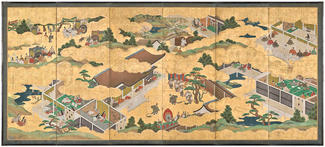
Nestled amid the golden clouds in this vibrant pair of screens are depictions of twelve chapters from the Tale of Genji, one of the world’s earliest novels. Written around the year 1000 by Murasaki Shikibu, a lady-in-waiting at the court in Kyoto, the story vividly portrays courtly customs through an intricate web of human relations. The protagonist Genji epitomizes the ideal male persona of the time: strikingly attractive and a master of all the arts, he was also a great lover. Indeed much of the long novel revolves around his liaisons with women of the court.
The earliest illustrations of the Tale of Genji are handscrolls of the early twelfth century. These paintings not only set the stylistic standards of the yamato-e (pictures of yamato, or Japan), but also influenced later renditions of the novel. This influence is apparent here in the bird’s-eye-view perspective and thick layering of pigment. The diagonal lines that run through the architectural elements heighten the emotional intensity of the scenes.
Although convention dictated that characters from the Tale of Genji should be shown devoid of emotion or individualization, the screens contain many interesting details. The musicians display an unusual range of facial expressions: some converse with one another, while one puffs out his cheeks to play a wind instrument. Such expressive displays can be seen in other Genji illustrations by the seventeenth century, but they are usually reserved for commoners and not the nobility who were considered composed at all times.
Also remarkable are the monochromatic ink landscapes drawn on the sliding doors and screens in the palace interiors depicted in the screens. These meticulously painted landscapes, dragons, birds, and flowers contrast sharply with the colorful screens themselves. This disparity might be intended to stress that the screens were a product of the Kan? school, whose painting styles and techniques were derived from Chinese ink painting (the kara-e pictures of Tang China) as opposed to yamato-e.
Source: Midori Oka, "Pair of Folding Screens: Scenes from the Tale of Genji," in Eye of the Beholder, edited by Alan Chong et al. (Boston: ISGM and Beacon Press, 2003): 186-87.